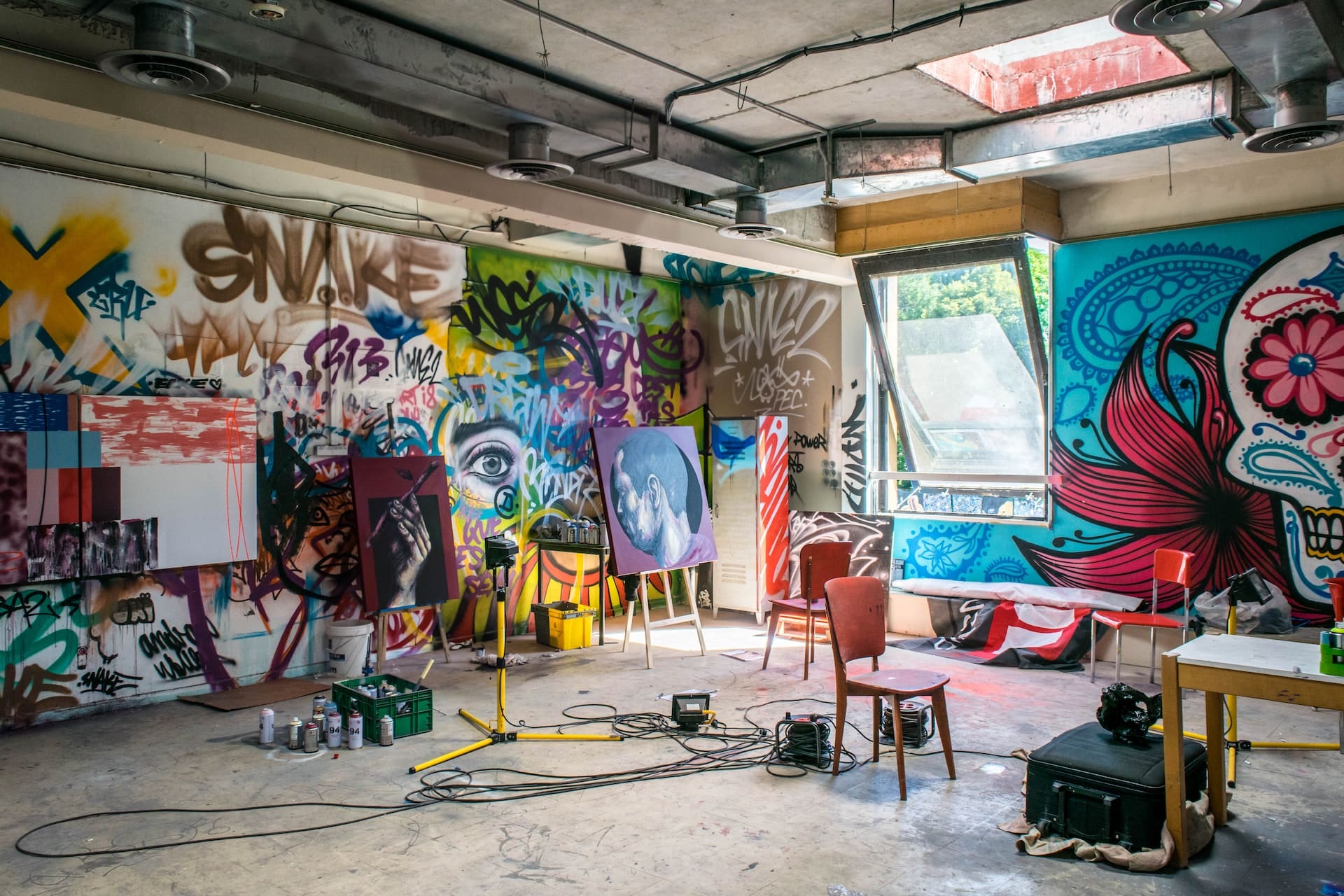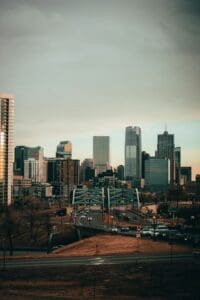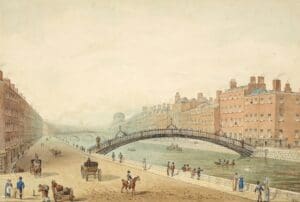By Ellie O’Byrne
See original post here.
Serge Vanden Berghe sits in his Cork city studio, surrounded by paints, brushes, many completed artworks and yet more half-finished. He opens his journal: in it, he records personal expenses, the hours he spends in his studio painting and sculpting, how he travels to work, even his well-being and state of mind.
“I feel myself, more than ever, a professional artist,” he says. “I produce more and the output is of a better quality, and the peace of mind has a lot to do with this.”
For over a year, 2,000 arts workers in areas including visual arts, theatre, literature, music, dance, opera, movies, circus arts and architecture have been receiving a payment equivalent to €325 per week under the Basic Income for the Arts three-year pilot scheme, and Vanden Berghe is amongst their number.
Supposedly modelled on the idea of Universal Basic Income and introduced by the Department of Tourism, Culture, Arts, Gaeltacht, Sport and Media, there are no strings attached for participating artists except one: to journal their experience and fill out six-monthly questionnaires on the merits of the scheme.
It was August 2022 when the artists were selected by lottery from 8,200 eligible applicants, and first payments were made in late October 2022. Vanden Berghe was initially delighted to have been selected for this rare opportunity, but then experienced something unexpected: guilt that he was selected while other artists he knew – and knew were struggling financially – hadn’t been.
Because arts workers in Ireland most certainly are struggling financially, living on a knife-edge of income precarity as they move from project to project. They are frequently self-employed, without the social protection catch-nets enjoyed by PRSI workers.
The BIA pilot was the primary recommendation of the Arts and Culture Recovery Taskforce Report, designed to resuscitate the arts sector after two years of covid measures, highlighted exactly how vulnerable to market vagaries arts and arts practitioners really were.
Artists are only half as likely to be homeowners as the general population, the taskforce report found, and one in 54 artists were “of no fixed abode”.
More than a year into the BIA payments, Vanden Berghe is delighted with how it’s been going. “That guilt is gone, the guilt of winning the lottery while others didn’t,” Vanden Berghe says. “The other realisation is that it’s not really winning the lottery because it’s not that much money. The value of money has changed even in the past year. It helps, but it doesn’t solve all your financial problems.”
Vanden Berghe paints brightly coloured canvases often featuring geometric elements and has been a fixture in Outlaw Studios in the old Ford Factory in Cork city for many years. A solo exhibition of his last year, Sacred Earth and Other Stories, saw him focus on sculpture to produce a series of 3D pieces inspired by holy reliquaries of the Middle Ages.
For many years, Vanden Berghe, a father of two now-adult children, was forced to put his art second to earning a living, often working in the construction end of the creative industries: he has worked in theatrical set design and constructing parade floats amongst other things.
“Beforehand I was not really a full-time visual artist: I was part-time, which has consequences for the work,” he says. “With the basic income, I can concentrate full-time on my art.” It is perhaps unsurprising that when you offer a cohort of people €1,400 per month that they overwhelmingly report being happy with the arrangement, especially against the current backdrop of the cost of living crisis and astronomical housing costs, but that is exactly what the first six-month impact assessment on the BIA scheme, published in December, has found.
BIA recipients were found to be 19.2% less likely to be having difficulties making ends meet than a control group of arts workers not on the BIA. They were spending more on materials and work spaces, and were spending more time working on their art and less time in other industries, even if the latter amounted to just three hours per week less.
Many of the positive results were in the areas of self-reported wellbeing and mental health: depression and anxiety had reduced for BIA applicants and life satisfaction had increased, albeit marginally, up half a point on a scale of one to 10.
Catherine Martin, Minister for Tourism, Culture, Arts, Gaeltacht, Sport and Media, said the first impact assessment “reaffirms the need for a scheme like the Basic Income for the Arts and for the accompanying research that will help in our efforts to support the arts in Ireland to thrive and grow.”
Vanden Berghe, a lifelong social activist who considers himself an anarchist, agrees, and also sees the scheme as a model for a broader Universal Basic Income scheme for other sectors of society. Why should artists be eligible while other vulnerable groups such as carers face ongoing battles to justify their need to the Department of Social Protection?
“It should be open to everybody,” he says. “Workers who are in precarious work would be able to make sound decisions with a safety net. It will help people make the right decisions, try out new things, maybe start a small family business.” To Vandenberghe, the reprieve from the poverty trap that BIA represents is part of an implicit social contract between himself and the community he makes art for. He feels an additional drive to make art, but has also been freer with volunteering his time for things he feels are of community benefit.
The plan now, he says, is to use the remaining two years of the scheme to consolidate his professional position.
“I think I’m more focused on my goals, which is to have a regular artist income of my own by the end of the three years. If I achieve that, the guilt will completely disappear. If I fail, the guilt will come back,” he says with a laugh.
The future of the scheme beyond 2025 is unknown. Will a pilot championed by Catherine Martin, whose party is more broadly in favour of Universal Basic Income, be looked on as favourably by her political successor?
THE BIA IN REVIEW
Arts consultants John O’Brien and Dr Annette Clancy have published a policy review of the BIA that took a slightly more critical look at the pilot scheme: while they described BIA as “a significant moment for the arts in Ireland”, they raised concerns in several areas, not least in relation to who is considered eligible.
“There are a lot of assumptions running underneath the BIA about who is an artist and how art gets made, which I think is really interesting,” Dr Clancy, director of the MA in Cultural Policy and Arts Management at University College Dublin, says.
“What the Government did was go back to the arts act of 1973 and look at the categories are identified there and say they would issue payments to people working in each of those sectors.
“What they leave out by only looking at those sectors are artists who are working in a collaborative way, and also a whole range of people who support the making of art, such as make-up artists: people who work collaboratively behind the scenes.”
While Dr Clancy broadly welcomes the first six-month report into the BIA, she says she’d like to see more transparency about the methods and metrics being used, and to see the research broadened beyond questionnaires.
“You have to ask whether a quantitative analysis is the most appropriate way of analysing BIA in the first place,” she says. “ If basic income is what this is about, why are we looking at hours and what people are doing with their time? That goes against the principle of a basic income. Why is there no reporting on a qualitative research model, for example interviews?”
“Richer data” would help to not only evaluate BIA but to see if it could work for other sectors too, she says: “It would be my hope that this is a trial and that it will be extended to other sectors as well.”
BIA FOR DISABLED ARTISTS
The policy review of of the BIA by John O’Brien and Dr Annette Clancy highlighted an issue of considerable concern: how BIA is working for disabled artists.
Because BIA is taxable income, means-tested benefits from the Department of Social Protection such as disability allowance or carer’s allowance can be cut for BIA recipients.
When writer, wheelchair user and disability activist Maryam Madani heard that she had been selected for the BIA pilot, she says it was “like a gift from the universe to say don’t give up on your dreams. It does feel like a blessing and a gift, and it really relieved the pressures so much and it is still an enormous relief.”
But when Madani reported to the Department of Social Protection that her circumstances had changed, she received a home visit from one of their inspectors which resulted in her disability allowance of €200 per week cut to €90.
BIA recipients are supposed to be able to earn from their art without it affecting BIA payments: that’s central to the idea of a basic income. But if disabled artists like Madani earn over and above the BIA by taking on more professional art work, they could face their disability being cut entirely.
“I have to be so careful that I don’t earn anything else from my art,” Madani says. “Disabled peoples’ energy and health varies so much that there’s a big fear of losing disability allowance because you don’t know when your health will fail you again, and nobody knows if the BIA will continue after three years.” Living with a disability costs between €8,000 and €12,000 per year over and above any other living costs, according to a report by consultants Indecon for the Department of Social Protection.
“Disability Allowance is supposed to cover the costs of having a disability,” Madani says.
“Disabled artists should be getting disability on top of any income that they make because it’s just to cover the basic costs of their disability. Being on disability is itself a poverty trap.”
Madani worries that for the disabled artists on the scheme – you would expect there to be at least 146 amongst 2,000 participants, if the rate of reported disability amongst artists from earlier government research, 7.3%, is correct – the result is that they feel they can’t accept commissions for their arts work even as non-disabled participants are incentivised to pursue other income.
“We can’t take any extra commissions without losing disability allowance,” she says, “so I’m being actively discouraged from taking on any work.” Madani is a writer, singer and a member of Undercurrent dance company. As an activist, she works with Disability Power Ireland and DADA (Disabled Artists and Disabled Academics) Campaign for Human Rights.
The disability conundrum is, she feels, a solvable problem for BIA. She believes the scheme should have a full-time access officer, better communication and integration with the Department of Social Protection, and support groups for BIA members both disabled and non-disabled.
She’s currently working on her first novel and says the BIA has, as with Vanden Berghe, lit a fire under her when it comes to her creative ambitions: she’s aiming to have completed her novel by the time the BIA scheme finishes.
“Basic Income for Arts has taken the pressure off me to seek work outside the arts,” she says. “I had been thinking that I would have to give up on writing and go and get some part-time work in other areas. Like other artists, it has given me the sense that I can work in the arts and explore my creativity in ways that I can’t when I’m worried about my financial situation.”





















